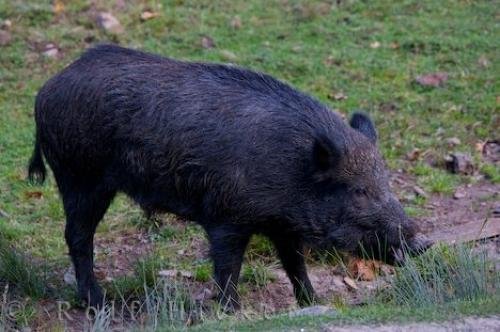Photo: Wild Boar Animal Parc Omega Montebello Quebec
A Black Wild Boar wandering around the grassland of Parc Omega in Montebello, Outaouais, Quebec in Canada.
Although the Parc Omega in Montebello, Outaouais in the province of Quebec, Canada is mainly a nature park for the wildlife of Canada the wild boar is not actually a native of North America.
The wild boar was introduced to the North American continent, in the 16th century, by Spanish explorers who raised them for food. As time went on some escaped and others were probably released into the wild. The Latin name for the wild boar is Sus Scrofa, which also includes wild swine, feral hogs and feral swine.
Wild boar can be black, brown or dark grey and can be quite large - up to 5 feet long and could weigh as much as 300 pounds. Their fur is quite coarse and stiff, the tail is thin and straight and both males and females have small tusks. A group of wild boar are called 'sounders' and usually consist of 2 or 3 females and their babies. ... continue below the picture...
Wild Boar Animal Parc Omega Montebello Quebec

Pictures from photo gallery "British Columbia Pictures"
This picture is part of the photo album "Animal Pictures" - there are more beautiful images waiting for you.
Related stock photo galleries, pictures & travel ideas:
Wild Boar Animal Parc Omega Montebello Quebec
... The males wander alone and only come around the sows at breeding time.
The wild boars living in the Parc Omega are lucky to be there, because the boar is considered to be an 'exotic pest'. They destroy many native plants when they forage for roots and when they wallow in water they disturb the vegetation of the pond or lake. It is necessary for the boar to cover themselves with wet mud to cool themselves as they have no sweat glands. The Parc Omega in Montebello, Outaouais, Quebec gives the visitor the opportunity to drive through the winding trail and see wild boar, moose, deer, wolves and many other animals in their natural enviroment.
Wild Boar, Sus scrofa, at Parc Omega in Montebello, Outaouais, Quebec, Canada.
Technical Information:
I photographed this photo with the digital SLR camera model Canon EOS-1Ds Mark II, aperture of f/6.3, exposure time of 1/320 sec. on ISO 400, as always I used a original Canon Lens, the focus lenght for this picture was 200mm.
A Black Wild Boar wandering around the grassland of Parc Omega in Montebello, Outaouais, Quebec in Canada.
